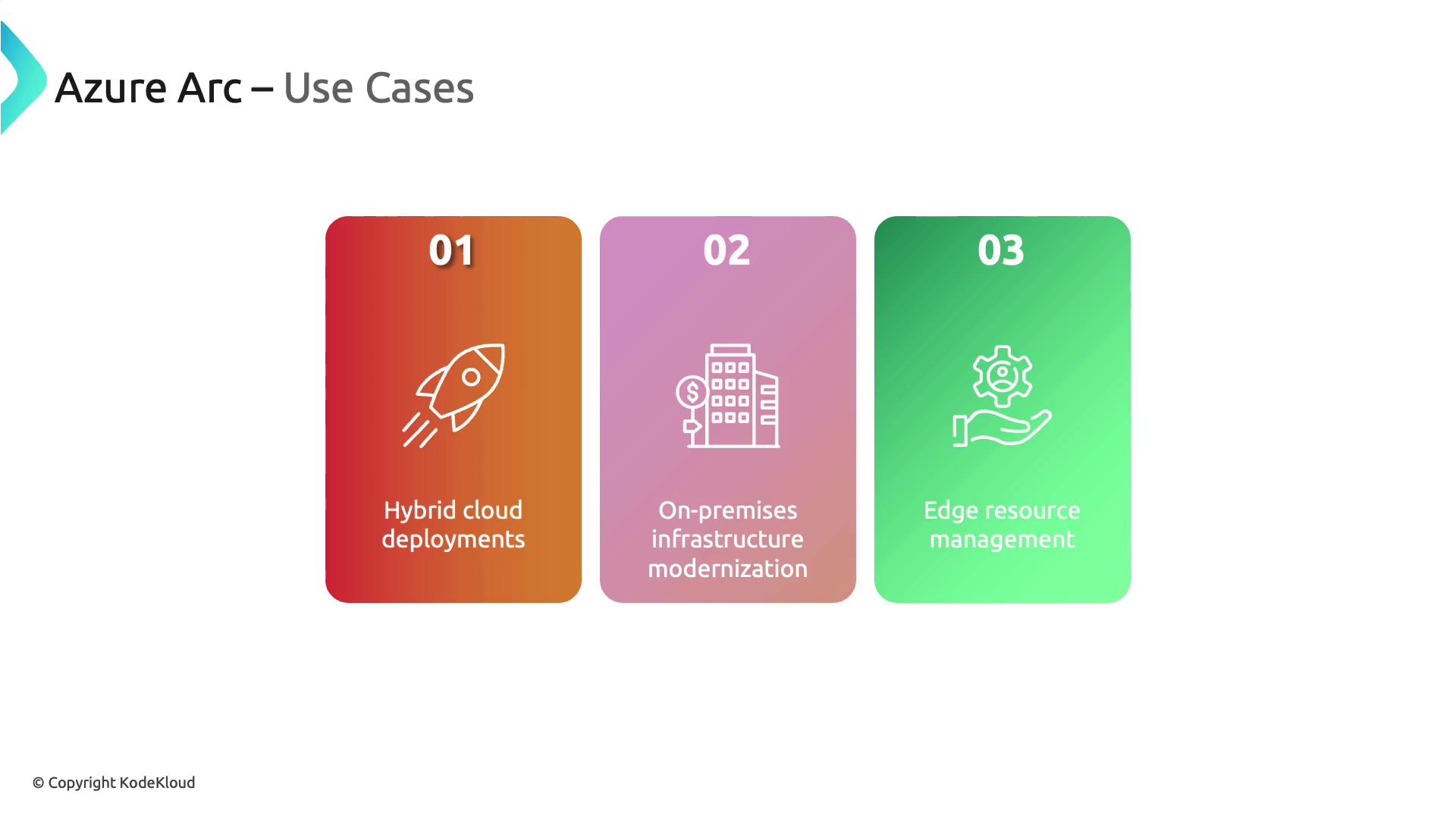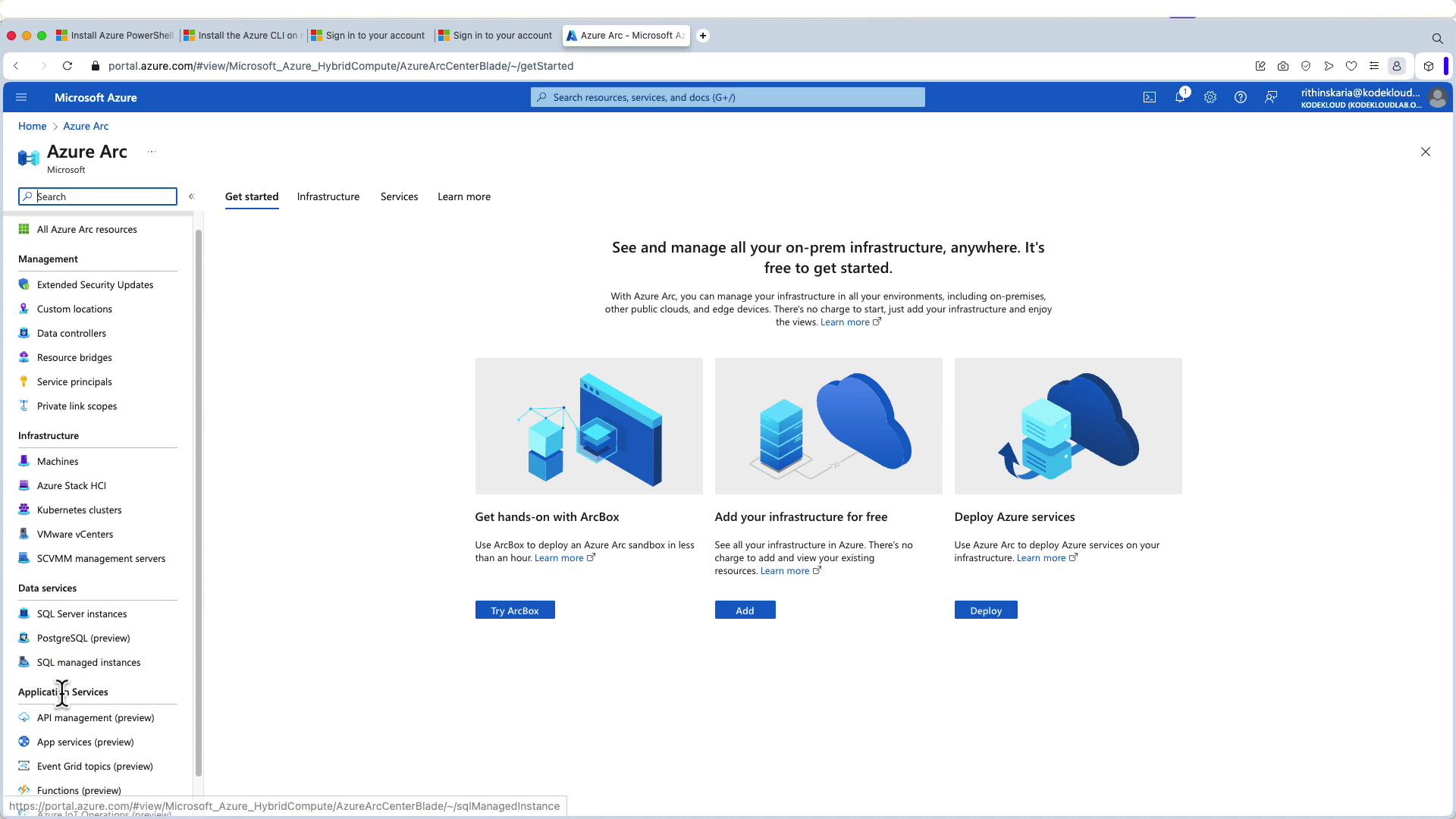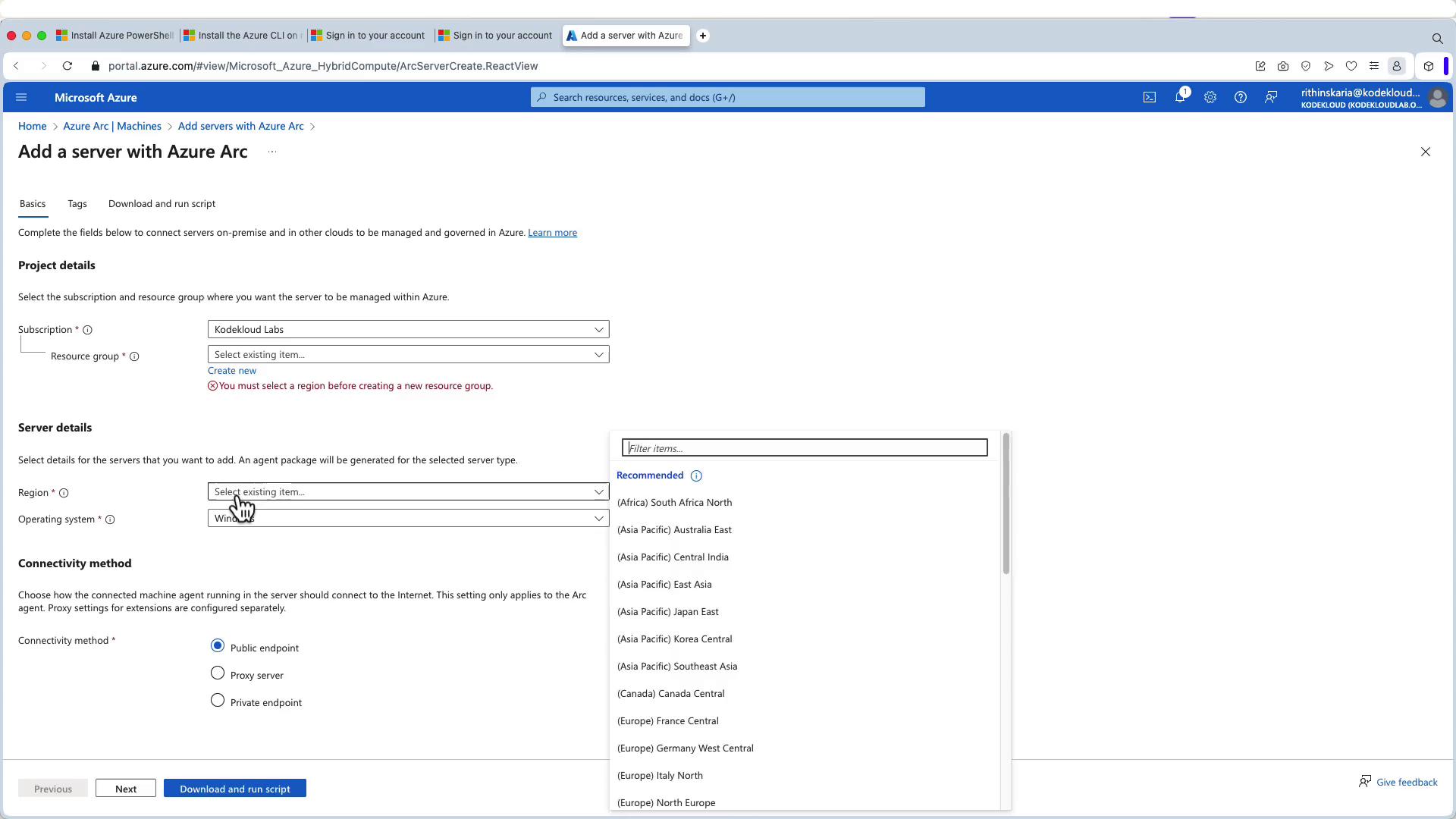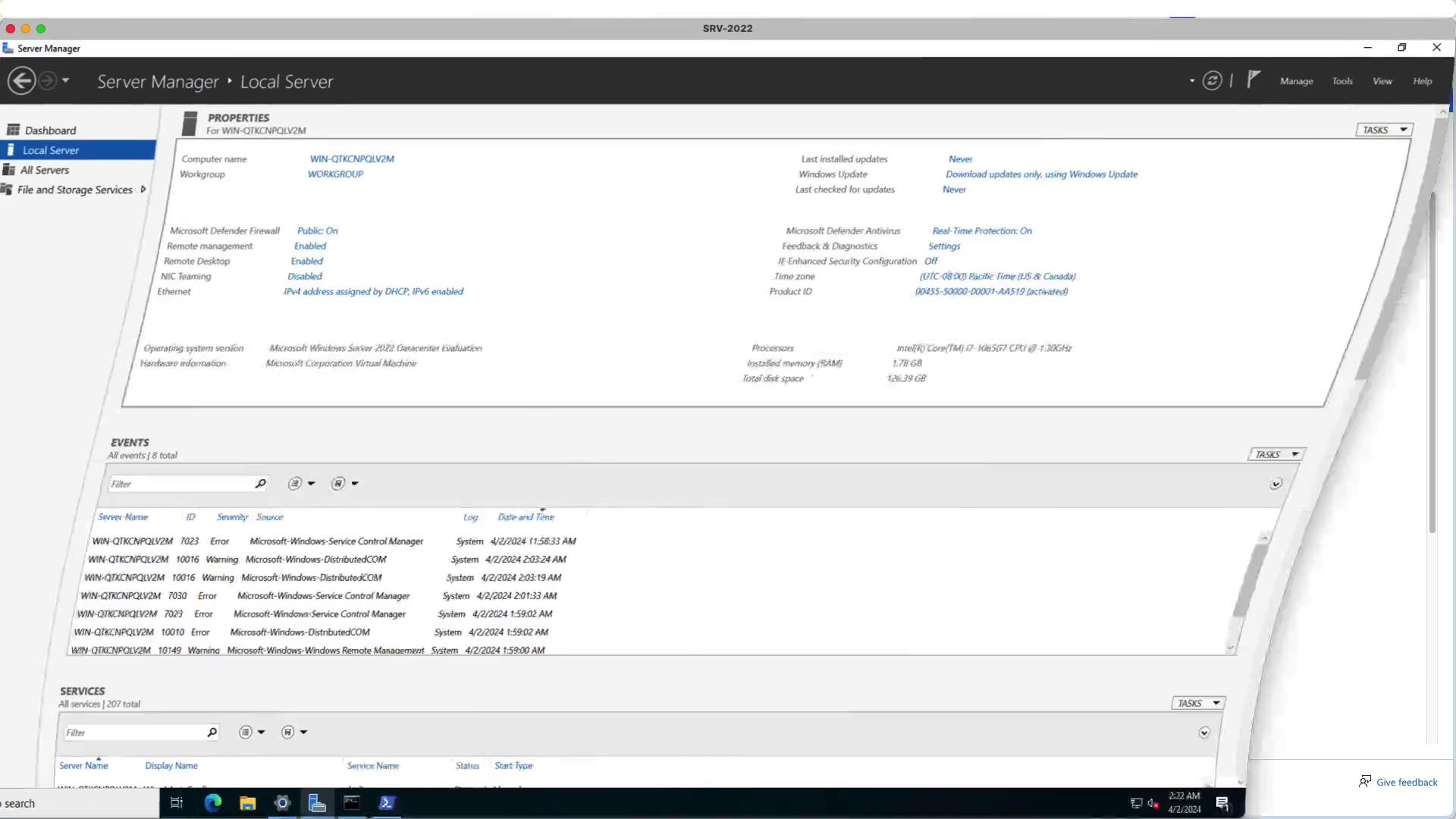AZ900: Microsoft Azure Fundamentals
Resource Deployment Tools
Azure Arc
Azure Arc extends Azure's powerful management capabilities to any infrastructure, whether on-premises, multi-cloud, or edge. With Azure Arc, organizations like Bella Innovation can manage servers across different environments directly from the Azure Portal, ensuring centralized control regardless of where your resources reside.
All connected resources become visible within the Azure Portal, and you can manage them using the Portal, PowerShell, or CLI. This is made possible by the Connected Machine Agent, which is installed on each machine to facilitate communication with Azure Arc.

Key Features of Azure Arc
Azure Arc delivers a range of robust features that help streamline hybrid and multi-cloud management:
- Unified Management: Centralize and manage resources across on-premises, multi-cloud, and edge environments using a single pane of glass.
- Extended Azure Services: Unlock the power of Azure services for your entire infrastructure, regardless of location.
- Policy-Driven Governance: Apply Azure policies to non-Azure resources to ensure consistent compliance, security, and operational practices.

Benefits and Use Cases
Azure Arc offers numerous benefits and is ideal for various use cases:
- Flexibility and Interoperability: Manage resources seamlessly regardless of whether they are on-premises, at the edge, or across multiple clouds.
- Streamlined Operations: Utilize familiar Azure tools for a consistent operational experience across all environments.
- Enhanced Security: Extend Azure’s security and identity services to maintain monitoring and robust protection for all connected resources.

The optimal scenarios for Azure Arc include hybrid cloud deployments, modernizing on-premises infrastructure, and managing edge resources.

Demonstration: Onboarding a Windows Server
This section walks you through onboarding an on-premises Windows Server to Azure Arc.
Pre-requisites
Ensure you have access to the Azure Portal, PowerShell, and appropriate administrative credentials before starting.
Step 1: Access the Azure Portal
Log in to the Azure Portal and navigate to the Azure Arc section. Azure Arc supports not only servers but also solutions such as Azure Stack HCI, Kubernetes clusters, VMware environments, and data services like SQL Server Managed Instances.

Step 2: Add a Machine
Click on "Add" or "Create" and select "Add a machine." While you can onboard multiple servers at once, this demonstration focuses on a single Windows server.
Step 3: Configure Server Details
Provide the necessary server details:
- Resource Group: Create a new group or select an existing one.
- Region: Choose a region, such as East US.
- Operating System: Select Windows.
- Public Endpoint Details: Enter the required public endpoint information.

Step 4: Generate and Download the Onboarding Script
After configuring the server details, click to generate and download the PowerShell script. This script installs the Connected Machine Agent and connects the server to Azure Arc.
Below is an example PowerShell script:
try {
$env:SUBSCRIPTION_ID = "1b278476-75fd-46ed-bd68-6a9966ed33a3"
$env:RESOURCE_GROUP = "ps-demo"
$env:TENANT_ID = "1e0fa212-37dc-45f7-bb4b-b6687ca264b"
$env:LOCATION = "eastus"
$env:AUTH_TYPE = "Token"
$env:CORRELATION_ID = "a63fa33c-3271-41b2-91ca-0e609c5adb83"
$env:CLOUD = "AzureCloud"
[Net.ServicePointManager]::SecurityProtocol = [Net.SecurityProtocolType]::Tls12
# Download the installation package
Invoke-WebRequest -UseBasicParsing -Uri "https://aka.ms/azureconnectedmachines" -TimeoutSec 30 -OutFile "$env:TEMP\install_windows_azcmagent.ps1"
# Install the hybrid agent
$env:TEMP = "\install_windows_azcmagent.ps1"
if ($LASTEXITCODE -ne 0) { exit 1; }
# Connect command
& "$env:ProgramW6432\AzureConnectedMachineAgent\azcmagent.exe" connect --resource-group "$env:RESOURCE_GROUP" --tenant "$env:TENANT_ID" --subscription-id "$env:SUBSCRIPTION_ID"
}
Download this script, transfer it to your Windows server (via Remote Desktop or another method), and execute it to install the Connected Machine Agent.

Step 5: Run the Onboarding Script
When you run the script, it will install the Azure Connected Machine Agent and prompt you to sign in via a pop-up browser:
The script begins installation and provides verbose logs similar to:
VERBOSE: Installing Azure Connected Machine Agent VERBOSE: PowerShell version: 5.1.20348.558 VERBOSE: .NET Framework version: 4.8.4161 VERBOSE: checking if this is an Azure virtual machine VERBOSE: Error The operation has timed out. checking if we are in Azure VERBOSE: Downloading agent package from https://aka.ms/AzureConnectedMachineAgent to C:\Users\ADMINI~1\AppData\Local\Temp\AzureConnectedMachineAgent.msi VERBOSE: Installing agent packageComplete the sign-in when prompted. After authentication, the script continues:
VERBOSE: Installing Azure Connected Machine Agent VERBOSE: Total Physical Memory: 1826 MB VERBOSE: .NET Framework version: 4.8.4161 VERBOSE: Checking if this is an Azure virtual machine VERBOSE: Error The operation has timed out. checking if we are in Azure VERBOSE: Installing agent package VERBOSE: Downloading agent package from https://aka.ms/Temp/AzureConnectedMachineAgent.msi INFO: Connecting machine to Azure... This might take a few minutes. INFO: Testing connectivity to endpoints that are needed to connect to Azure... INFO: Please login using the pop-up browser to authenticate. 20% 30% INFO: Creating resource in Azure... /subscription/1b228746-75fd-46ed-8a6b-6a906d6d6d3a/resourceGroups/ps-demo/providers/Microsoft.HybridCompute/machines/WI-N-QTKCNPLV2M
Once the script finishes, your Windows Server is successfully onboarded to Azure Arc.
Step 6: Verify Onboarding in the Azure Portal
Return to the Azure Portal and navigate back to the Azure Arc section. Confirm that your server appears with its hostname and details. You can now manage policies, run commands, and view logs just like any Azure resource—even if the server resides on-premises.

Key Takeaway
By onboarding your Windows Server to Azure Arc, you extend Azure's robust management, security, and compliance capabilities to your on-premises resources, simplifying hybrid and multi-cloud operations.
This demonstration highlights how Azure Arc empowers you to extend cloud management capabilities to on-premises environments. With Azure Arc, you can apply policies, perform updates, and monitor performance from a single management platform.
Next, we will explore Azure Resource Manager and its advanced infrastructure management features.
Watch Video
Watch video content